|
|
|
Sort Order |
|
|
|
Items / Page
|
|
|
|
|
|
|
| Srl | Item |
| 1 |
ID:
181465


|
|
|
|
|
| Summary/Abstract |
To realize the “Green” economic development, China has to transform the extensive mode of growth with the power factor inputs being the main driving force gradually into an intensive one. It's important to quantitatively analyze the relationship between the power factor input and economic growth and understand the core factors that affect the coordinated development between them. We introduce the concept of “power dependence,” based on the counter-factual method, use “growth drag” to reflect the dependence of China's economic growth on the power factor input. Based on the measurement of national power dependence, the auto-regressive distributed lag (ARDL) model is used to develop an empirical analysis of its influencing factors, and the robustness of the findings is tested by using the inter-provincial panel data. The findings show that China's economic growth has depended on the power factor input to some extent. According to the results, we propose suggestions from the aspects of promoting economic development, improving the pricing mechanism, adjusting the power generation structure, reasonably regulating the introduction of the foreign direct investment and research and development investment, and optimizing industrial structure to find an effective means to reduce the dependence of China's economic growth on the power factor input.
|
|
|
|
|
|
|
|
|
|
|
|
|
|
|
|
| 2 |
ID:
150824
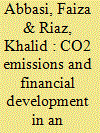

|
|
|
|
|
| Summary/Abstract |
This paper explores the influence of economic and financial development on carbon emissions in a small emerging economy. The study employs ARDL approach to investigate the long run relationship between carbon emissions and a set of economic and financial variables, an Error Correction Model (ECM) to capture the short run dynamics, Granger causality in an augmented VAR framework to check the causality direction, and variance decomposition based on an estimated Vector Error Correction Model (VECM) to determine the relative contributions of economic and financial variables to the evolution of per capita carbon emissions. The periods considered were the full sample (1971–2011), and a reduced sample sub-period (1988–2011) that corresponded to greater liberalization and financial sector development. The financial variables played a role in emission mitigation only in the latter period where greater degree of liberalization and financial sector development occurred. Even then the relative magnitude of emissions mitigation attributable to financial variables was much smaller compared to the emissions raising impact of rising per capita incomes. This underscores the need for adopting other mitigation policies for reducing carbon footprints in those emerging economies where a sufficient degree of financial deepening and financial sector development has not yet taken place.
|
|
|
|
|
|
|
|
|
|
|
|
|
|
|
|
| 3 |
ID:
187361
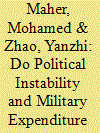

|
|
|
|
|
| Summary/Abstract |
Previous studies have investigated the relationship between political instability and economic growth separately from the relationship between military expenditure and economic growth. Besides, they did not cover the period after 2011 (i.e. the Arab Spring and its consequences). Therefore, this paper attempts to empirically analyze the long-run and short-run impacts of both political instability and military expenditure on economic growth in Egypt. We estimate the autoregressive distributed lag (ARDL) approach using data on the Egyptian economy over the period 1982–2018. For the robustness of our results, we use the fully modified ordinary least squares (FMOLS) estimator. Results of the ARDL approach indicate a significant negative relationship between political instability and economic growth in both the long-run and short-run. Contrarily, military expenditure has an insignificant impact on economic growth, especially in the long-run. These results are confirmed by the FMOLS estimator. Moreover, the estimated coefficient on the one-period lagged error correction term (ECTt-1) indicates that deviations from the long-run equilibrium relationship are corrected within a year.
|
|
|
|
|
|
|
|
|
|
|
|
|
|
|
|
| 4 |
ID:
177832
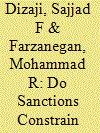

|
|
|
|
|
| Summary/Abstract |
Do sanctions reduce military spending in Iran? To answer this question, we use annual data from 1960 to 2017 and the autoregressive distributed lag (ARDL) model. We show that an increase in the intensity of sanctions is associated with a larger decrease in military spending in both the short and the long run. Each level of increase in the intensity of sanctions with respect to our coding approach decreases military spending in the long run by approximately 33%, ceteris paribus. We also find that only the multilateral sanctions, in which the United States acts in conjunction with other countries to sanction Iran, have a statistically significant and negative impact on military spending of Iran in both the short and the long run. Multilateral sanctions reduce Iran’s military spending by approximately 77% in the long run, ceteris paribus. The results remain robust when controlling for other determinants of military spending such as gross domestic product (GDP), oil rents, trade openness, population, quality of political institutions, military expenditure of the Middle East region, non-military spending of government and the war period with Iraq.
|
|
|
|
|
|
|
|
|
|
|
|
|
|
|
|
| 5 |
ID:
125858


|
|
|
|
|
| Publication |
2013.
|
| Summary/Abstract |
This study revisits the growth-inequality-environment nexus in the context of country-specific time series data. The short- and long-run effects of income inequality, economic growth and energy consumption on CO2 emissions in the U.S. are examined using the autoregressive distributed lag (ARDL) approach. We find that more equitable distribution of income in the U.S. results in better environmental quality in the short- and long-run. It is also found that, in both the short- and long-run, economic growth has a beneficial effect on environmental quality, whereas energy consumption has a detrimental effect on the environment.
|
|
|
|
|
|
|
|
|
|
|
|
|
|
|
|
| 6 |
ID:
088958


|
|
|
|
|
| Publication |
2009.
|
| Summary/Abstract |
This study probes nexus between electricity supply, employment and real GDP for India within a multivariate framework using autoregressive distributed lag (ARDL) bounds testing approach of cointegration. Long-run equilibrium relationship has been established among these variables for the time span 1970-71 to 2005-06. The study further establishes long- and short-run Granger causality running from real GDP and electricity supply to employment without any feedback effect. Thus, growth in real GDP and electricity supply are responsible for the high level of employment in India. The absence of causality running from electricity supply to real GDP implies that electricity demand and supply side measures can be adopted to reduce the wastage of electricity, which would not affect future economic growth of India.
|
|
|
|
|
|
|
|
|
|
|
|
|
|
|
|
| 7 |
ID:
143527
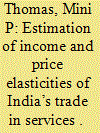

|
|
|
|
|
| Summary/Abstract |
India’s international trade in services benefited immensely from the change in policy stance from import substitution to export promotion in the post-1991 period. Services trade received a further boost when India became signatory to the World Trade Organization (WTO) in 1995. This article aims to estimate the income and price elasticities of India’s services trade during the post-WTO period, using the autoregressive distributed lag (ARDL) approach to cointegration, for the time period starting from 1996–97 Q1 (Quarter 1) to 2011–12 Q4 (Quarter 4). This study finds that the long-run income elasticity of services export is quite high and statistically significant, when the gross domestic product (GDP) of the Organisation for Economic Co-operation and Development countries is taken as proxy for GDP of importing countries. However, the price elasticity of services export is found to be statistically insignificant. In case of services import, both the income and price elasticities of demand are found to be statistically significant, and services import is found to be more responsive to income than relative prices. The implications of the empirical findings for India’s current account deficit are also explored.
|
|
|
|
|
|
|
|
|
|
|
|
|
|
|
|
| 8 |
ID:
122454
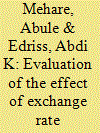

|
|
|
|
|
| Publication |
2013.
|
| Summary/Abstract |
Research was conducted to find out the effects of exchange rate variability, terms of trade, competitiveness and gross domestic product on the dominant export crop of Ethiopia, coffee. This study employs annual time series data (1992-2010) and uses the autoregressive distributive lag (ARDL) model augmented by the Wald test. The results reveal that exchange rate variability has a negative effect on the export of coffee in the short run, but is insignificant in the long run. This implies that, over time, exchange rate changes in the country have been favouring the export performance of coffee. Regardless of exchange rate variability, the competitiveness of the country, explained by real effective exchange rates, improved, but the price of coffee did not increase relative to the price of imports, which has resulted in deteriorating terms of trade. To improve the worsening terms of trade and benefit from policy changes, export diversification and value addition are possible solutions the country should focus on.
|
|
|
|
|
|
|
|
|
|
|
|
|
|
|
|
| 9 |
ID:
175899
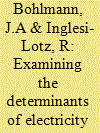

|
|
|
|
|
| Summary/Abstract |
For the period 1975–2016, this paper examines the determinants of the residential demand for electricity in South Africa including disposable income, electricity prices, food prices as well as the impact of the 2007/08 load-shedding wave and the 2008 electricity price restructuring. Given the high income inequality levels in South Africa, this relationship was investigated at aggregated and disaggregated income levels. Based on an Autoregressive Distributed Lag (ARDL) model, the empirical results indicate long-run cointegration between residential electricity consumption, gross national disposable income, electricity prices and food prices. Disposable income elasticities have a positive sign for the aggregate and all income groups, indicating that as income increases, South African households consume more electricity (normal good). As expected, price elasticities are negative and significant – for both the aggregated and disaggregated models – indicating that electricity prices do influence electricity demand for all South African households. The paper also examines the complementarity or substitutability of food and electricity. At both the aggregated and disaggregated income levels, the results showed that food and electricity are substitute goods for all South African households. However, as expected, the magnitude of this relationship is marginally different for each income group.
|
|
|
|
|
|
|
|
|
|
|
|
|
|
|
|
| 10 |
ID:
132691


|
|
|
|
|
| Publication |
2014.
|
| Summary/Abstract |
In this article, we explore the long-run cointegration between output, capital and energy consumption, in per worker terms, for Albania, Bulgaria, Hungary and Romania. We use the augmented Solow (1956) model and the ARDL bounds procedure (Pesaran et al., 2001) to examine the short-run and long-run effects of energy and capital on output (in per worker terms). We also conduct causality test using the Toda and Yamamoto (1995) non-causality procedure. Our results show the existence of long-run cointegration between output per worker and energy per worker for all the four countries. We find that energy per worker have a dynamic short-run positive effect in Albania (0.37%), Bulgaria (0.25%), Hungary (0.36%) and Romania (0.68%), and a long-run positive effect in Bulgaria (0.32%) and Romania (0.63%) which duly indicate that energy consumption has a momentous long-run effect in these two countries. The causality results indicate a unidirectional causation from output per worker to energy per worker for all the four countries, and from capital per worker to energy per worker for Albania and Romania. Consequently, a balance between effective energy consumption and sound energy conservation policies are likely to support economic growth in the four countries.
|
|
|
|
|
|
|
|
|
|
|
|
|
|
|
|
| 11 |
ID:
182550
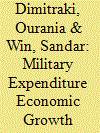

|
|
|
|
|
| Summary/Abstract |
The Hashemite Kingdom of Jordan is a nation that has persisted through turbulent times. The country’s leaders have long attempted to balance the allocation of resources between a strong military and a developing economy in their quest for stability, peace and prosperity. This paper examines and sheds further light on the relationship between Jordan’s military expenditure and its economic growth during the period 1970–2015. Using the Gregory -Hansen cointegration technique allowing for structural breaks, and the ARDL methodology this paper tests the short – and long–run equilibrium relationship between military expenditure and economic growth in Jordan. Furthermore, with the error correction model (ECM) and the CUSUM and CUSUMSQ tests, we examine the stability of the above relationship. The results reveal positive short – and long–run relationships between military expenditure and economic growth in Jordan, during the period under study. This finding has important policy implications for the Jordanian state, as it justifies the transfer of resources to the military, showing that it has not had a negative impact on economic growth.
|
|
|
|
|
|
|
|
|
|
|
|
|
|
|
|
| 12 |
ID:
132518


|
|
|
|
|
| Publication |
2014.
|
| Summary/Abstract |
This article investigates the role of the final expenditure components in determining Nepal's imports from India using the Autoregressive Distributed Lag approach based on the annual data for the period 1975-2011. The results of bounds testing procedure show that there exists the cointegration between Nepal's imports from India and its determinants: personal consumption expenditure, government consumption expenditure, investment, exports and relative prices. Among the expenditure components, personal consumption expenditure is a major determinant of import demand from India, with its significant positive impact. The government expenditure is found to have no significant impact on Nepal's imports from India. Gross domestic investment and exports have negative impact on Nepal's import demand from India, whereas the relative prices have positive impact, indicating lack of substitutes for Indian imports. Trade liberalization also has positive impact on Nepal's import from India.
|
|
|
|
|
|
|
|
|
|
|
|
|
|
|
|
|
|
|
|
|